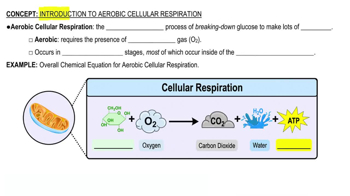Here are the essential concepts you must grasp in order to answer the question correctly.
Cellular Fusion
Cellular fusion is the process by which two or more cells combine to form a single cell. In the case of plasmodial slime molds, individual amoeboid cells can merge together, resulting in a large, multinucleate structure. This phenomenon allows for the sharing of resources and genetic material, contributing to the organism's ability to adapt and thrive in various environments.
Recommended video:
Introduction to Cellular Respiration
Multinucleation
Multinucleation refers to the presence of multiple nuclei within a single cell. In plasmodial slime molds, this occurs as a result of repeated cellular divisions without cytokinesis, the final step of cell division. This unique structure enables the organism to coordinate cellular activities across a large volume, enhancing its efficiency in nutrient absorption and response to environmental changes.
Recommended video:
Plasmodium Formation
Plasmodium formation is a specific developmental stage in slime molds where individual cells aggregate to form a large, multicellular structure. This process is often triggered by environmental factors such as food availability or moisture. The resulting plasmodium is a dynamic, amoeboid mass that can move and grow, allowing the organism to explore its environment and optimize resource acquisition.
Recommended video:
 Verified step by step guidance
Verified step by step guidance Verified video answer for a similar problem:
Verified video answer for a similar problem:

